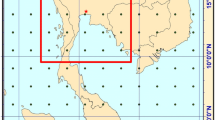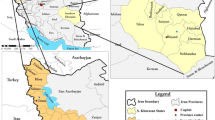Abstract
Many of the applied techniques in water resources management can be directly or indirectly influenced by hydro-climatology predictions. In recent decades, utilizing the large scale climate variables as predictors of hydrological phenomena and downscaling numerical weather ensemble forecasts has revolutionized the long-lead predictions. In this study, two types of rainfall prediction models are developed to predict the rainfall of the Zayandehrood dam basin located in the central part of Iran. The first seasonal model is based on large scale climate signals data around the world. In order to determine the inputs of the seasonal rainfall prediction model, the correlation coefficient analysis and the new Gamma Test (GT) method are utilized. Comparison of modelling results shows that the Gamma test method improves the Nash–Sutcliffe efficiency coefficient of modelling performance as 8% and 10% for dry and wet seasons, respectively. In this study, Support Vector Machine (SVM) model for predicting rainfall in the region has been used and its results are compared with the benchmark models such as K-nearest neighbours (KNN) and Artificial Neural Network (ANN). The results show better performance of the SVM model at testing stage. In the second model, statistical downscaling model (SDSM) as a popular downscaling tool has been used. In this model, using the outputs from GCM, the rainfall of Zayandehrood dam is projected under two climate change scenarios. Most effective variables have been identified among 26 predictor variables. Comparison of the results of the two models shows that the developed SVM model has lesser errors in monthly rainfall estimation. The results show that the rainfall in the future wet periods are more than historical values and it is lower than historical values in the dry periods. The highest monthly uncertainty of future rainfall occurs in March and the lowest in July.











Similar content being viewed by others
References
Ahmadi A, Han D, Karamouz M, and Remesan R 2009 Input data selection for solar radiation estimation; Hydrol. Process. 23 (19) 2754–2764, doi: 10.1002/hyp.7372.
Araghinejad S and Burn D H 2005 Probabilistic forecasting of hydrological events using gestatistical analysis; Hydrol. Sci. J. 50 (5) 838–856.
Araghinejad S, Burn D H, and Karamouz M 2006 Long-lead probabilistic forecasting of streamflow using ocean-atmospheric and hydrological predictors; Water Resour. Res. 42 W03431.
Bae D, Jeong D M, and Kim G 2007 Monthly dam inflow forecasts using weather forecasting information and neuro-fuzzy technique; Hydrol. Sci. J. 52 (1) 99–113.
Bray M and Han D 2004 Identification of support vector machines for runoff modelling; J. Hydroinformatics 6 (4) 265–280.
Chen D and Chen Y 2003 Association between winter temperature in China and upper air circulation over East Asia revealed by canonical correlation analysis; Global Planet. Change 37 315–325.
Choy K Y and Chan C W 2003 Modelling of river discharges and rainfall using radial basis function networks based on support vector regression; Int. J. Syst. Sci. 34 (14–15) 763–773.
Conway H, Gades A, and Raymond C F 1996 Albedo of dirty snow during conditions of melt; Water Resour. Res. 32(6), doi: 10.1029/96WR00712.
Dutta S C, Ritchie J W, Freebairn D M, and Yahya Abawi G 2006 Rainfall and streamflow response to El Niño Southern Oscillation: A case study in a semi-arid catchment, Australia; Hydrol. Sci. J. 51 (6) 1006–1020.
Galeati G 1990 A comparison of parametric and non-parametric methods for runoff forecasting; Hydrol. Sci. J. 35 (1) 79–94.
Ghosh S and Mujumdar P P 2008 Statistical downscaling of GCM simulations to streamflow using relevance vector machine; Adv. Water Resour. 31 132–146.
Hanssen-Bauer I, Forland E J, Haugen J E, and Tveito O E 2003 Temperature and precipitation scenarios for Norway: Comparison of results from dynamical and empirical downscaling; Clim. Res. 25 15–27.
Hashmi M Z, Shamseldin A Y, and Melville B W 2011 Comparison of SDSM and LARS-WG for simulation and downscaling of extreme precipitation events in a watershed; Stochastic Environmental Research and Risk Assessment 25 (4) 475–484, doi: 10.1007/s00477-010-0416-x.
Haylock M R et al. 2006 Trends in total and extreme south American rainfall in 1960–2000 and links with sea surface temperature; J. Climate 19 1490–1512.
Johansson B and Chen D 2003 The influence of wind and topography on precipitation distribution in Sweden: Statistical analysis and modelling; Int. J. Climatol. 23 1523–1535.
Karamouz M, Zahraie B, Fatahi E, Mirzaie E, Remezani F and Hashemi R 2005 Predictors for long-lead precipitation forecasting in western Iran, The First Iran–Korea JointWorkshop on Climate Modelling, Nov. 16–17, Mashahd, Iran.
Karamouz M, Ahmadi A, and Moridi A 2009 Probabilistic reservoir operation using Bayesian Stochastic Model and Support Vector Machine; Adv. Water Resour. 32 1588–1600, doi: 10.1016/j.advwatres.2009.08.003.
Karamouz M, Mojahedi A and Ahmadi A 2010 Interbasin water transfer: An economic-water quality based model; J. Irrig. Drain. Eng., ASCE 136(2) 90–98, doi:10.1061/(ASCE)IR.1943-4774.0000140
Karlsson M and Yakowitz S 1987 Rainfall-runoff forecasting methods, old and new; Stoch. Hydrol. Hydraul. 1 303–318.
Kember G and Flower A C 1993 Forecasting river flow using nonlinear dynamics; Stoch. Hydrol. Hydraul. 7 205– 212.
Liu X and Coulibaly P 2011 Downscaling ensemble weather predictions for improved week-2 hydrologic forecasting; J. Hydrometeorol. 12 1564–1580, doi: 10.1175/2011JHM1366.1.
Moghaddamnia A, Ghafari M, Piri J, and Han D 2009 Evaporation estimation using support vector machines technique; Int. J. Eng. Applied Sci. 5 (7) 415–423.
Mpelasoka F, Mullan A B, and Heerdegen R G 2001 New Zealand climate change information derived by multivariate statistical and artificial neural network approaches; Int. J. Climatol. 21 1415–1433.
Najafi M, Moradkhani H, and Wherry S 2011 Statistical downscaling of precipitation using machine learning with optimal predictor selection; J. Hydrol. Eng. 16 (8) 650–664, doi: 10.1061/(ASCE)HE.1943-5584.0000355.
Nash J E and Sutcliffe J V 1970 River flow forecasting through conceptual models. Part 1 – A discussion of principles; J. Hydrol. 10 (3) 282–290.
Nourani V, Alami M T, and Aminfar M H 2009 A combined neural-wavelet model for prediction of Ligvanchai watershed precipitation; Eng. Appl. Artificial Intell. 22 (3) 466–472.
Salas J D, Deulleur J W, Yevjevich V, and Lane W L 1980 Applied modelling of hydrologic time series, Water Resources Publications, Littleton, Colorado, USA.
Schoof J T and Pryor S C 2001 Downscaling temperature and precipitation: A comparison of regression-based methods and artificial neural networks; Int. J. Climatol. 21 773–790.
Sivapragasam C and Liong S Y 2005 Flow categorization model for improving forecasting; Nordic Hydrol. 36 (1) 37–48.
Toddini E 2000 Real-time flood forecasting: Operational experience and recent advances; In: Flood Issues in Contemporary Water Management (eds) Marsalek J, Watt E, Zeman E and Sieker F, Kluwer Academic Publishers, pp. 261–270.
Vapnik V 1995 The Nature of Statistical Learning Theory, Springer, New York.
Vapnik V 1998 Statistical Learning Theory, Wiley, New York.
Widmann M and Bretherton C S 2003 Statistical precipitation downscaling over the northwestern United States using numerically simulated precipitation as a predictor; J. Climate 16 (5) 799–816.
Wilby R L and Tomlinson O J 2000 The ‘Sunday Effect’ and weekly cycles of winter weather in the UK; Weather 55 214–222.
Wilby R L, Hay L E, and Leavesley G H 1999 A comparison of downscaled and raw GCM output: Implication for climate change scenarios in the San Juan River Basin, Colorado; J. Hydrol. 225 67–91.
Wilby R L, Dawson C W, and Barrow E M 2002 A decision support tool for the assessment of regional climate change impacts; Environmental and Modelling Softwares 17 145–157.
Xoplaky E, Gonzales-Rouco J F, Luterbacher J, and Wanner M 2004 Wet season Mediterranean precipitation variability: Influence of large-scale dynamics and trends; Clim. Dyn. 23 63–78.
Yu X Y, Liong S Y, and Babovic V 2004 EC-SVM approach for real-time hydrologic forecasting; J. Hydroinform. 6 (3) 209–223.
Author information
Authors and Affiliations
Corresponding author
Rights and permissions
About this article
Cite this article
Ahmadi, A., Moridi, A., Lafdani, E.K. et al. Assessment of climate change impacts on rainfall using large scale climate variables and downscaling models – A case study. J Earth Syst Sci 123, 1603–1618 (2014). https://doi.org/10.1007/s12040-014-0497-x
Received:
Revised:
Accepted:
Published:
Issue Date:
DOI: https://doi.org/10.1007/s12040-014-0497-x




